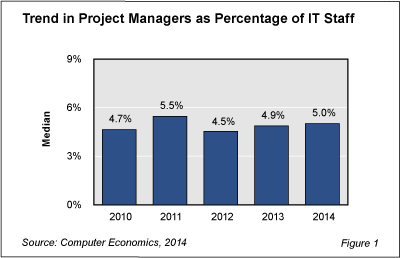IT organizations today are relying more on professional project managers than even a few years ago. The reasons for this growth are varied: new technology adoption, regulatory compliance issues, outsourcing, and the ever-present mandate to do more with less all contribute to the need for project management.
Perhaps the most pressing reason for the growth in project management personnel is that many organizations have a poor record of bringing IT projects in on time and within budget. Worse yet, many projects fail to meet key requirements, and some never reach completion. Much of the work in IT organizations today is project-based, and IT managers realize that project management is a critical element in delivering successful projects—and thus, value—to the business.
Figure 1 from our study, IT Project Management Staffing ratios, shows that in 2014, project managers made up 5.0% of the IT staff at the median for the composite sample. There appears to be a gradual rise from the median 4.5% level in 2012, coinciding with renewed growth in IT spending. Over the entire five-year period, however, the median ratio has remained relatively constant.

Over the longer term, these levels represents a new high for this function. Prior to the recession, our data indicates project management staffing levels averaged a full percentage point lower. While it could be argued that the slowdown in capital spending should result in fewer projects and thus fewer project managers, the data indicates project management becomes more valued when budgets are tight and projects are being altered or outsourced.
In the full study, we examine the question of how many project managers a typical IT organization requires. We present five benchmarks: project managers as a percentage of the IT staff, users per project manager, application developers per project manager, applications per project manager, and capital budget per project manager. All of these ratios are presented by organization size. In addition, we look at the influence of sector on project management staffing. We conclude with recommendations on assessing the performance of the project management function.
The data in Figure 1 is useful for assessing recent trends, but for benchmarking purposes we provide benchmarks by organization size, which has a large influence on staffing ratios. We also provide a range of values from the 25th percentile to the 75th percentile. The range provides guidance on how variable staffing is from organization to organization.
In today’s environment, the role of the IT project manager is critical. Although the project manager is not responsible for the direct creation of project deliverables such as systems design, program code, or documentation, he or she is responsible for ensuring that these deliverables are completed according to plan. The project manager is trained in methodologies and equipped with the tools to guide the project through its various stages, from building the initial business case to assessing the project’s success at closure.
This Research Byte is a brief overview of our report on this subject, IT Project Management Staffing Ratios. The full report is available at no charge for Computer Economics clients, or it may be purchased by non-clients directly from our website (click for pricing).
Do you also need staffing ratios for other IT job functions? Consider this collection of all of our staffing ratio reports, which bundles them all into a single report at a significant discount: IT Staffing Ratios–Special Report Bundle.

